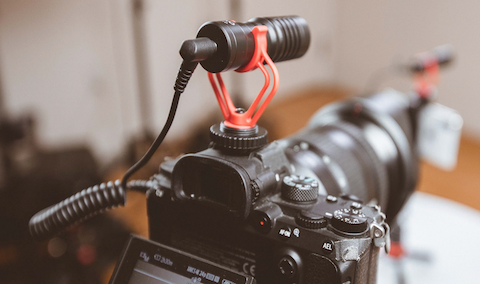Your Cart is Empty
 Free Shipping
Free ShippingEnjoy the convenience of free shipping on all orders. We believe in transparent pricing and delivering value straight to your doorstep. read more...
 30-Day Money-Back Guarantee
30-Day Money-Back GuaranteeShop with confidence knowing you have a full 30 days to try our products. If you're not completely satisfied, return your purchase for a full refund, no questions asked. read more...
 2-Year Warranty
2-Year WarrantyWe stand by the quality of our products with an industry-leading 2-year warranty. Enjoy peace of mind knowing your vlogging and podcasting equipment is covered against defects and issues. read more...
 Lifetime Customer Support
Lifetime Customer SupportOur commitment to you doesn't end at purchase. With lifetime customer support, you can reach out to our expert team anytime for help, advice, or troubleshooting, ensuring you always get the best performance from your gear. read more...

by Dave Correa February 11, 2021
Trying to get your audio devices to work together can be a headache if you don’t know the difference between the connectors they use. Even then, there are so many different combinations of connection types.
Learning how to distinguish between these cables is vital for knowing which one is the right pick for you. For starters, if you are looking for an adapter for your smartphone, chances are you need a TRRS cable. If you have never heard of TRRS before, or aren’t sure what a TRRS adapter does, don’t worry - we’ve put together an easy to understand guide that is here to help.
What Does “TRRS” Even Mean?
“TRRS” stands for “Tip-Ring-Ring-Sleeve”, which refers to each of the four contact points on the audio connector. TRRS connectors are also sometimes calledfour pole connectors, in reference to the number of contact points, and can be visually identified by counting the number of rings on the male end of the connector.
Why Do I Need an Adapter?
Even though many electronic devices utilize 3.5mm diameter connectors, not all of them are compatible with each other. TRRS connectors are most commonly used in smart devices like smartphones and tablets, but products like cameras, computers, and microphones typically feature three pole TRS interfaces.
A TRRS plug may be able to physically fit inside a TRS port (and vice versa,) but the difference in contact points will render the connection invalid and prevent communication between devices. In order to enable two incompatible devices to be able to work together, you’ll need an adapter cable that features the appropriate connectors for each of the devices you want to use.
TRRS to TRS Adapters
Since so many devices utilize 3.5mm diameter audio ports, the TRRS to TRS adapter is one of the most common connector cables you can find. Because of this, there are many different variants, each serving their own purpose.
The Movo MC3 adapter enables compatibility between smartphones and audio devices like microphones and headphones. The 3-pole TRRS connector plugs directly into your phone’s 3.5mm port, while the device you want to connect it to plugs into the adapter’s TRS port.
The MC4, on the other hand, features a male TRS plug and a female TRRS input. This adapter is useful for using TRRS headphones or mics with a DSLR camera or recorder that utilizes 3.5mm TRS input.
For connecting into female input ports on two devices, the CFP-1 has you covered. With male 3.5mm TRS and 3.5mm TRRS connectors, the CFP-1 is able to connect your smartphone to mics, recorders, and more without the need for any additional cables.
TRRS to TRRS Adapters
In some cases, compatibility between your devices is not the problem - it’s actually connecting them. A TRRS to TRRS adapter doesn’t convert your connection type in any way, but rather provides additional cable length, allowing you to reach otherwise inaccessible locations.
If you just want to increase the length of your TRRS cable, the PM10EC6 is the cord for you. This male to female TRRS extension cable adds 20 feet to your connection, perfect for situations where you need some distance between your phone and the device it’s plugged into.
Splitter Cables
The previously mentioned adapters were all designed to connect one device to another, but there are also cables that can connect three devices together. These cables are called “splitters”, or sometimes “Y-splitters” due to their distinctive shape.
Splitters are useful when it’s not enough to connect just one device to your smartphone. Thankfully, Movo has you covered with our range of TRRS Y-splitters. The TCB1 plugs into your smartphone with a TRRS connector, but branches out into 3.5mm TRS inputs for both mics and headphones.
Similarly, the TCB2 allows use of both a microphone and headset, but the mic input is for XLR mics, not 3.5mm. This is great for linking more advanced, studio-grade microphones to your smartphone.
In Conclusion . . .
There are even more types of adapters that enable compatibility with TRRS smartphones. TRRS to USB-C adapters, TRRS to Lightning adapters, TRRS to TS adapters . . . the list goes on. Whatever device you choose to connect with your smartphone, odds are that there is an adapter cable to make that happen.
With the knowledge that you’ve gained from this guide, you are now able to make an informed decision about which adapter is right for you. For more information, tutorials, and deals for audio equipment, check out our website and subscribe to our YouTube channel.We’re a team of creators and entrepreneurs who proudly support the content creation community through innovative, high-quality products that let you do you. From filmmakers to photographers, vloggers to podcasters, and beyond, Movo helps you share your creative voices across countless mediums and content platforms everywhere.
Receive access to exclusive deals, updates, and more.



